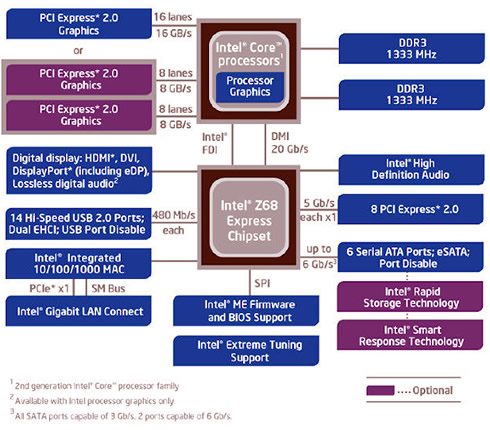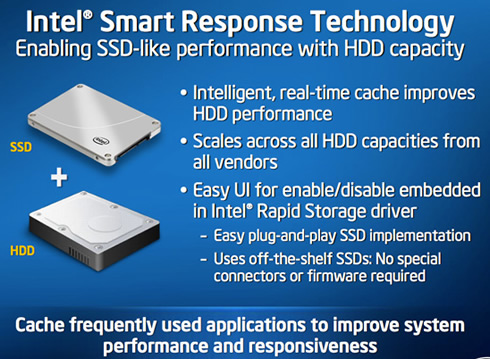
Intel Z68 Chipset Comes With New Features
Intel on Wednesday released the second-generation chipset for the Sandy bridge processors, the Intel Z68 Express, which packs all the new features of the H67 and P67 chipsets into a single chip.
Intel's H67 can tap Sandy's QuickSync logic for video transcoding, while the P67 holds the keys to CPU overclocking. However, you can't adjust CPU multipliers with the H67 or enjoy QuickSync with the P67, though.
Intel has finally seen fit to roll back the restrictions with its Z68 Express chipset. The platform combines full support for Sandy Bridge's built-in GPU with unfettered CPU overclocking controls. Intel has also given the Z68 a little something extra in the form of an SSD caching scheme dubbed Smart Response Technology.


The Z68 features dual Serial ATA controllers: one with a pair of 6Gbps ports and a second with four 3Gbps ports. Eight PCI Express 2.0 lanes provide bandwidth for expansion slots and peripherals, while 14 USB 2.0 ports highlight the lack of built-in SuperSpeed connectivity. The Z68 Express also has an HD audio interface and a Gigabit Ethernet MAC.
Although Sandy Bridge's 16 PCI Express 2.0 lanes are built into the CPU and make no contact with the chipset, Intel won't let them be split evenly in a dual-x8 configuration on H67 motherboards. The P67 has no such limitation for CrossFire or SLI setups, and neither does the Z68.
Gigabyte, Asus, and MSI are bundling their Z68 motherboards with Lucid's Virtu GPU Virtu switchable graphics software to harness the capabilities of Intel Quick Sync Video for faster video transcoding and the performance of the latest NVIDIA and AMD graphics cards. The Virtu graphics virtualization engine works in conjunction with Intel Quick Sync Video and promises to deliver up to three times faster and smoother video transcoding and playback. This is achieved by instantly switching between integrated Sandy Bridge graphics and a discrete graphics card on demand.
The Intel IGP has to be the primary display adapter for QuickSync to work, so you'll always need at least one display hooked up to the motherboard. Virtu allows additional monitors to be fed by a discrete graphics card, though. When you're playing games, the contents of the discrete GPU's frame buffer are copied over to the IGP's frame buffer in much the same manner as Nvidia's Optimus switchable graphics technology for notebooks.
Virtu support is limited to the Radeon HD 4000, 5000, and 6000 series from AMD and the GeForce 200, 400, and 500 series from Nvidia.
Intel Smart Response Technology is also available to accelerate hard drive performance and reduce energy consumption. This uses a solid-state cache to deliver the combined benefits of SSD speed and traditional hard drive storage capacity, cutting down on lengthy data access and system boot times in the process. This feature also reduces redundant hard drive spin, which lowers energy consumption and PC running costs.

Intel's Smart Response Technology is an exclusive to the new chipset. The feature is an intelligent caching technology that puts an SSD between the hard drive and operating system. The scheme uses logic built into the chipset's storage controller and drivers to populate a solid-state drive with frequently accessed data and incoming writes.
Smart Response is capable of caching writes immediately, but data must be read at least once to make it onto the SSD.
To enable Smart Response, the Z68's SATA controller must first be put into RAID mode. From there, one selects the hard drive to accelerate and how much of the SSD's capacity the cache will occupy. The cache needs at least 18GB and will only consume up to 64GB. You can use any SSD you'd like.
Smart Response process runs in maximized or enhanced mode. Enhanced mode is the default mode and it used the write-through cache method to write data to the cache memory and the disk simultaneously. In the even that the accleerated disk or volume becomes inaccessible, fails, or is disconnected, there is no risk of data loss because data on the disk is always synchronized with the data in the cache memory. The user can move his hard drive to a new system without bringing the SSD in tow.
Write caching is available in maximized mode. To guard against data loss, Smart Response works constantly to push cached writes to the hard drive and freshen the data it has stored for reads. The hard drive won't be perfectly in sync with the SSD in maximized mode, so migrating that kind of setup to a new system requires moving the SSD and hard drive together or disabling the cache beforehand.
Intel also today announced the 311 series of SSDs (Larson Creek), designed specifically for the Smart Response caching scheme.
The $110 SSD offers 20GB of 34-nm SLC NAND tied to the same storage controller used for the X25-M line.
The 2.5" form factor Intel SSD 311 Series can be added to an Intel Z68 Express Chipset desktop system by using one of the multiple standard hard drive bays. For Small Form-Factor (SFF) and All-In-one (AOI) systems, the mSATA Intel SSD 311 Series saves space by mounting the device on the motherboard and not utilizing a hard drive bay. The mSATA form factor is up to eight (8) times smaller than a 2.5" hard drive, and weighs less than 10 grams.
Intel also todayreleased an HD Graphics driver update for the 2nd Generation Intel Core processor family. Mainstream gaming just got more fun, with up to 40% performance improvements on select games, support for the latest games like Valve?s Portal 2 and Stereoscopic 3D playback on DisplayPort monitors. This driver also includes support for 1080p Blu-Ray playback and Intel Insider content playback over WiDi 2.0. Drivers can be found in 32-bit and 64-bit flavors.


Intel has finally seen fit to roll back the restrictions with its Z68 Express chipset. The platform combines full support for Sandy Bridge's built-in GPU with unfettered CPU overclocking controls. Intel has also given the Z68 a little something extra in the form of an SSD caching scheme dubbed Smart Response Technology.


The Z68 features dual Serial ATA controllers: one with a pair of 6Gbps ports and a second with four 3Gbps ports. Eight PCI Express 2.0 lanes provide bandwidth for expansion slots and peripherals, while 14 USB 2.0 ports highlight the lack of built-in SuperSpeed connectivity. The Z68 Express also has an HD audio interface and a Gigabit Ethernet MAC.
Although Sandy Bridge's 16 PCI Express 2.0 lanes are built into the CPU and make no contact with the chipset, Intel won't let them be split evenly in a dual-x8 configuration on H67 motherboards. The P67 has no such limitation for CrossFire or SLI setups, and neither does the Z68.
Gigabyte, Asus, and MSI are bundling their Z68 motherboards with Lucid's Virtu GPU Virtu switchable graphics software to harness the capabilities of Intel Quick Sync Video for faster video transcoding and the performance of the latest NVIDIA and AMD graphics cards. The Virtu graphics virtualization engine works in conjunction with Intel Quick Sync Video and promises to deliver up to three times faster and smoother video transcoding and playback. This is achieved by instantly switching between integrated Sandy Bridge graphics and a discrete graphics card on demand.
The Intel IGP has to be the primary display adapter for QuickSync to work, so you'll always need at least one display hooked up to the motherboard. Virtu allows additional monitors to be fed by a discrete graphics card, though. When you're playing games, the contents of the discrete GPU's frame buffer are copied over to the IGP's frame buffer in much the same manner as Nvidia's Optimus switchable graphics technology for notebooks.
Virtu support is limited to the Radeon HD 4000, 5000, and 6000 series from AMD and the GeForce 200, 400, and 500 series from Nvidia.
Intel Smart Response Technology is also available to accelerate hard drive performance and reduce energy consumption. This uses a solid-state cache to deliver the combined benefits of SSD speed and traditional hard drive storage capacity, cutting down on lengthy data access and system boot times in the process. This feature also reduces redundant hard drive spin, which lowers energy consumption and PC running costs.

Intel's Smart Response Technology is an exclusive to the new chipset. The feature is an intelligent caching technology that puts an SSD between the hard drive and operating system. The scheme uses logic built into the chipset's storage controller and drivers to populate a solid-state drive with frequently accessed data and incoming writes.
Smart Response is capable of caching writes immediately, but data must be read at least once to make it onto the SSD.
To enable Smart Response, the Z68's SATA controller must first be put into RAID mode. From there, one selects the hard drive to accelerate and how much of the SSD's capacity the cache will occupy. The cache needs at least 18GB and will only consume up to 64GB. You can use any SSD you'd like.
Smart Response process runs in maximized or enhanced mode. Enhanced mode is the default mode and it used the write-through cache method to write data to the cache memory and the disk simultaneously. In the even that the accleerated disk or volume becomes inaccessible, fails, or is disconnected, there is no risk of data loss because data on the disk is always synchronized with the data in the cache memory. The user can move his hard drive to a new system without bringing the SSD in tow.
Write caching is available in maximized mode. To guard against data loss, Smart Response works constantly to push cached writes to the hard drive and freshen the data it has stored for reads. The hard drive won't be perfectly in sync with the SSD in maximized mode, so migrating that kind of setup to a new system requires moving the SSD and hard drive together or disabling the cache beforehand.
Intel also today announced the 311 series of SSDs (Larson Creek), designed specifically for the Smart Response caching scheme.
The $110 SSD offers 20GB of 34-nm SLC NAND tied to the same storage controller used for the X25-M line.
The 2.5" form factor Intel SSD 311 Series can be added to an Intel Z68 Express Chipset desktop system by using one of the multiple standard hard drive bays. For Small Form-Factor (SFF) and All-In-one (AOI) systems, the mSATA Intel SSD 311 Series saves space by mounting the device on the motherboard and not utilizing a hard drive bay. The mSATA form factor is up to eight (8) times smaller than a 2.5" hard drive, and weighs less than 10 grams.
Intel also todayreleased an HD Graphics driver update for the 2nd Generation Intel Core processor family. Mainstream gaming just got more fun, with up to 40% performance improvements on select games, support for the latest games like Valve?s Portal 2 and Stereoscopic 3D playback on DisplayPort monitors. This driver also includes support for 1080p Blu-Ray playback and Intel Insider content playback over WiDi 2.0. Drivers can be found in 32-bit and 64-bit flavors.






















